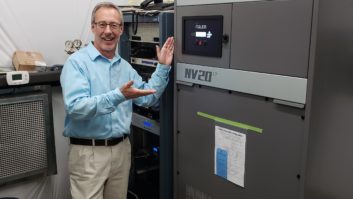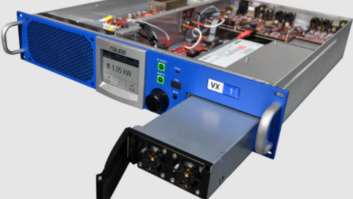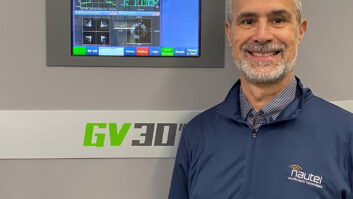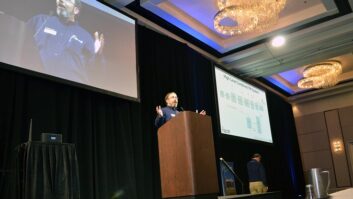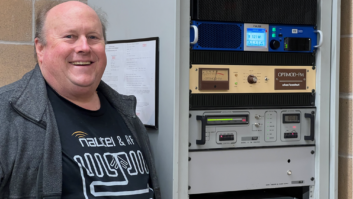Field Report: Nautel NV20
May 1, 2009 12:00 PM, By Bill Eisenhamer

When we started the plan to install HD Radio in 2008, we allowed ourselves a year to meet the deadlines. The 2008 NAB Show was around the corner, so we looked at what manufacturers had available or might be planned. Our needs sounded simple: two stations (KIFM and KBZT), two HD Radio transmitters.
The usual thoughts of tube vs. solid-state were considered, but we had more direct concerns. The transmitter had to be the right size physically and produce 10kW of analog power with digital. Combined solid-state looked likely, but the external combiner presented some space issues. Were we going to have to give up one, maybe two, full-powered analog backups? I did not like that prospect.
A group from Lincoln Financial Media met with Nautel to see the new NV40 solid-state transmitter. After seeing the unit, I began to lose focus on the talk. The talk ended and I said, �Cut that in half and we will get two of them.� Though the comment was not a sale, when Nautel said our end-of-year deadline of having the transmitters on site could be met, the off-the-cuff comment became reality. We took delivery of the first NV20s on Dec. 24, 2008.
Planned installation
Working with pre-installation documentation based on the NV40, our electrician prepared the wiring. When the transmitters arrived, they were a perfect physical fit in our tight space. To the surprise of Nautel I had the first transmitter operating into a dummy load by lunch time. I poked around the Advanced User Interface (AUI) and found the AUI more intuitive to navigate than expected. By the end of the day I had both transmitters running into their respective dummy loads at full TPO of 10kW, analog-only mode. Not bad for a day’s work.
Performance at a glanceOccupies less than one square yard
Advanced User Interface software control
Up to 22kW maximum analog
Ethernet accessible The remote interface wiring to the Burk remote control system was easy to install as the preconfigured interface on the NV20 had all the inputs and outputs I planned to use. We ran our AES audio feeds to the new NVE300 exciters. These exciters are based on the M50 core, but are redesigned to fit within the transmitter.
In a short time we learned how to balance the power modules via their own bias settings to make the HD Radio mask perfect. We discovered that the factory swapped the bias settings between the KIFM and KBZT transmitters by accident. When all was said and done, KBZT was on the air in digital and we had the ability to put KIFM on the air in digital.
The transmitter
The Nautel NV20 is a solid-state FM transmitter capable of running in analog, digital and hybrid modes. The footprint of this box is amazingly small for the power levels attained.
Centered in the front door is the 17″ touch-screen AUI display. There are no buttons on the front; all operations are performed through the AUI or with switches accessible on the controller board when the door is open. Ethernet access also displays the same information as the AUI and both run independently.
The remote interface board is buffered by opto-couplers on the controller board. The remote-control wiring is sectioned to eight-pin screw headers making it easy to connect. All remote functions are user-configurable through the AUI.
The reject load assemblies are behind the plate that supports the controller board. Below these are the eight RF power modules. Below these are the 20 power supplies. Two supplies power each hot-swappable power module for redundancy. The other four run the IPAs and the fans, two each. Below these are the low-voltage power supplies, again two each for redundancy.
Field Report: Nautel NV20
May 1, 2009 12:00 PM, By Bill Eisenhamer

The NV20”s AUI display
Up to two NVE300 exciters fit inside beside the power supply bays. In our installation we feed AES audio to the exciter, and we feed the RBDS and subcarrier client separately via the SCA 2 and SCA 3 BNC jacks, but the exciter also provides SCA, RBDS and analog audio inputs on a DB connector configured through the AUI. The exciter interfaces with the controller and AUI through a standard CAT-5 cable. A pilot/MPX sample port is provided on a BNC.
A Web server is built in for monitoring and rare configuration changes. If a second exciter is installed, the transmitter will recognize it as soon as it is connected and powered. The AUI can be configured to run from either exciter or failover automatically. An RS-232 connection is provided for troubleshooting to a deeper level.
More on the AUI
Welcome to a fully software-controlled transmitter. The display is intuitive and took little coaching to navigate the main parameters. The main display shows the power settings, modulation metering, a group of instrumentation panels, user-configurable real-time meters, and a row of control and menu buttons. The status button is multicolored depending on the state of certain parameters with green being normal, yellow a warning, and red as trouble.
NautelP
W
E 207-947-8200
www.nautel.com
[email protected]
The menu button provides a graphical list of options to access the presets, hardware configuration, software configurations, remote input/output configuration and change-over configurations. The AUI can be configured with user accounts allowing for different levels of access to the system. Event logging is phenomenal.
The presets are where all the station-specific parameters are entered. Much of this information is preconfigured and other presets can be built on.
After the learning curve and the excellent support Nautel has provided I have been quite satisfied by the operation and very confident the transmitters will hold their own.
We needed a box to fit our small space. With that, we also have the issue of heat generated by a solid-state transmitter running in hybrid mode. As I write, an improvement to the efficiency of the transmitter is one of Nautel’s concerns. As these boxes are so new, a couple of minor issues were found with the controller. There are things to be said about a software-controlled transmitter, and the fixes were all software-based. I could not have asked for a better transmitter for our application.
Eisenhamer is the chief engineer of Lincoln Financial Media Co. of CA.
Editor’s note: Field Reports are an exclusive Radio magazine feature for radio broadcasters. Each report is prepared by well-qualified staff at a radio station, production facility or consulting company.
These reports are performed by the industry, for the industry. Manufacturer support is limited to providing loan equipment and to aiding the author if requested.
It is the responsibility of Radio magazine to publish the results of any device tested, positive or negative. No report should be considered an endorsement or disapproval by Radio magazine.





